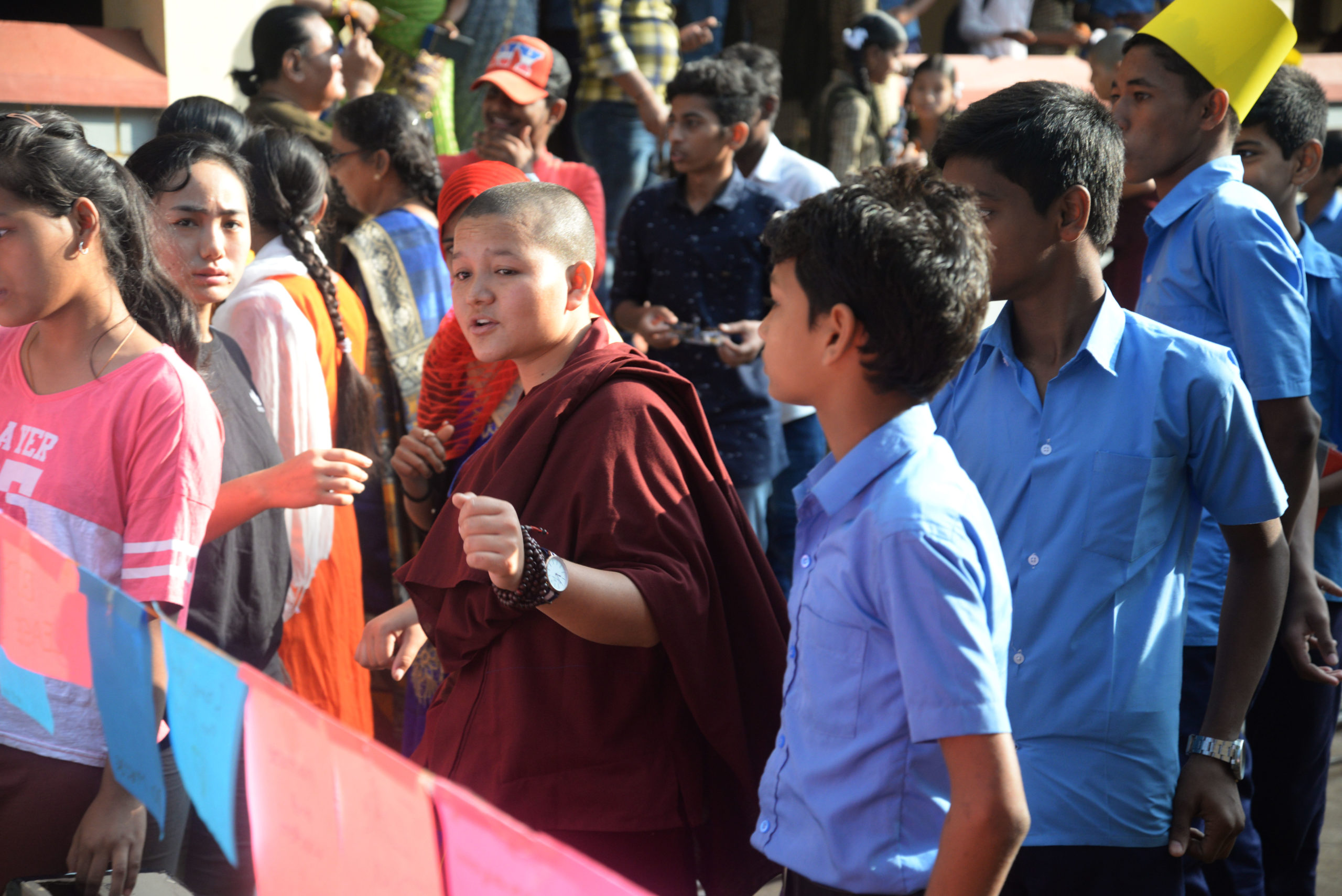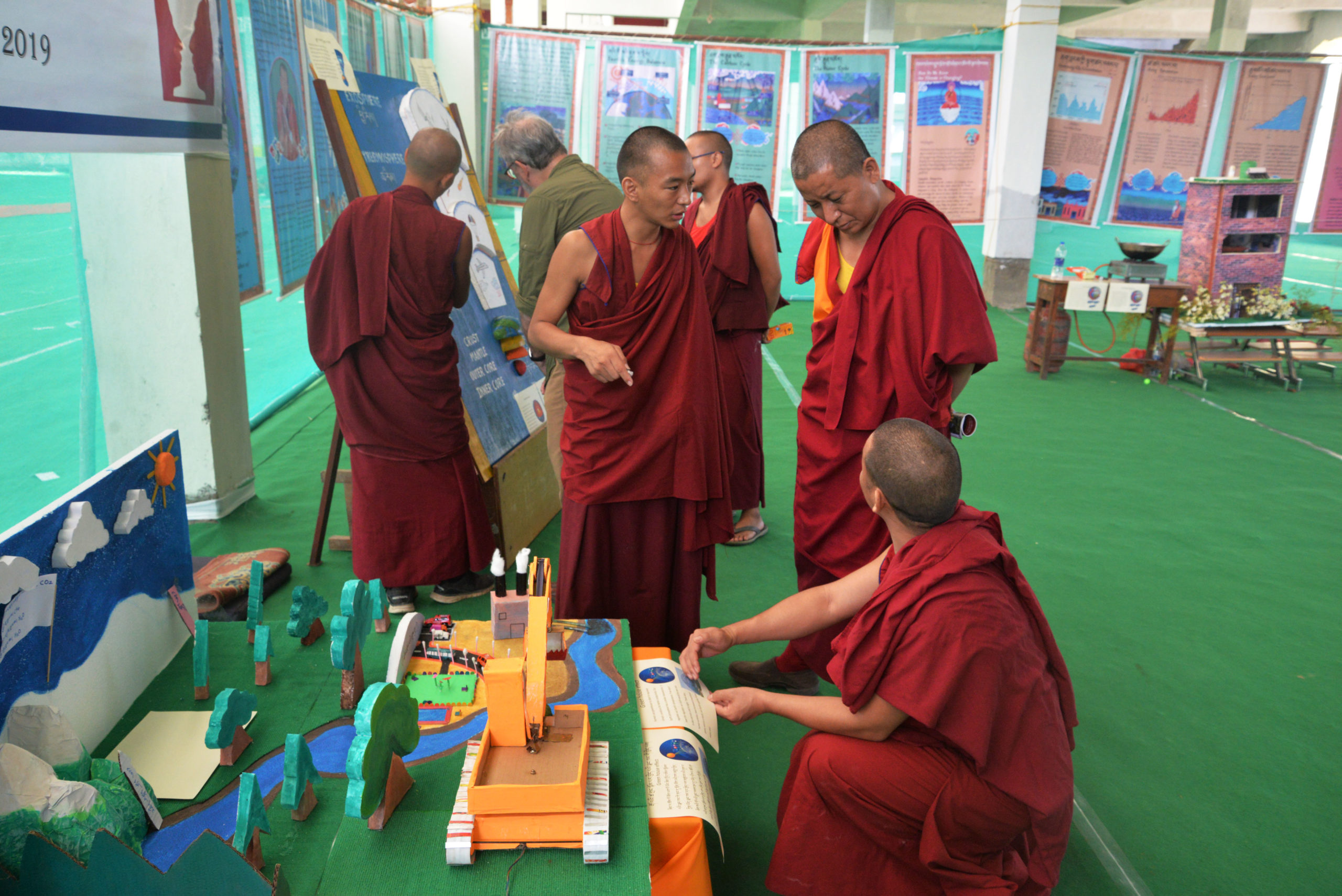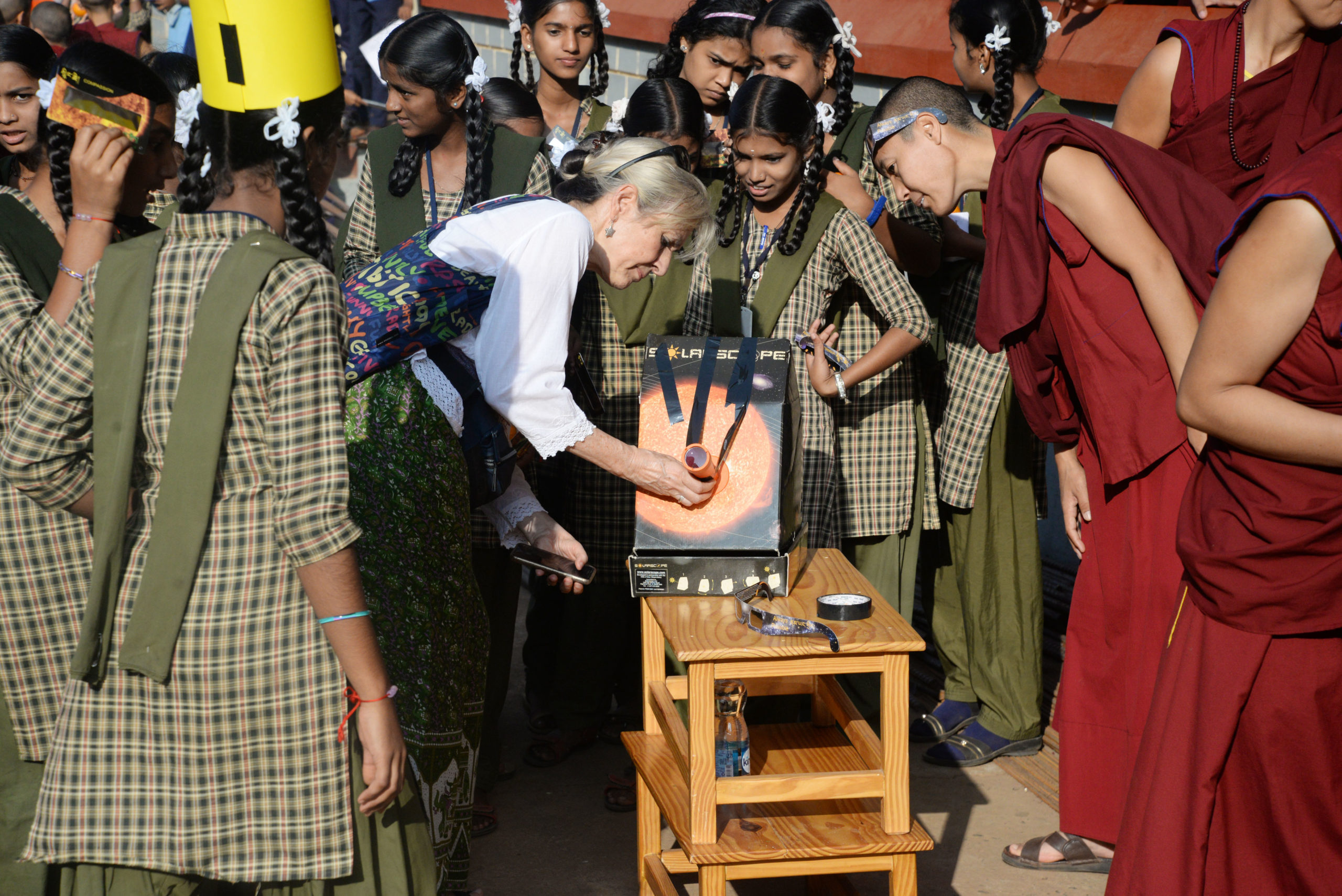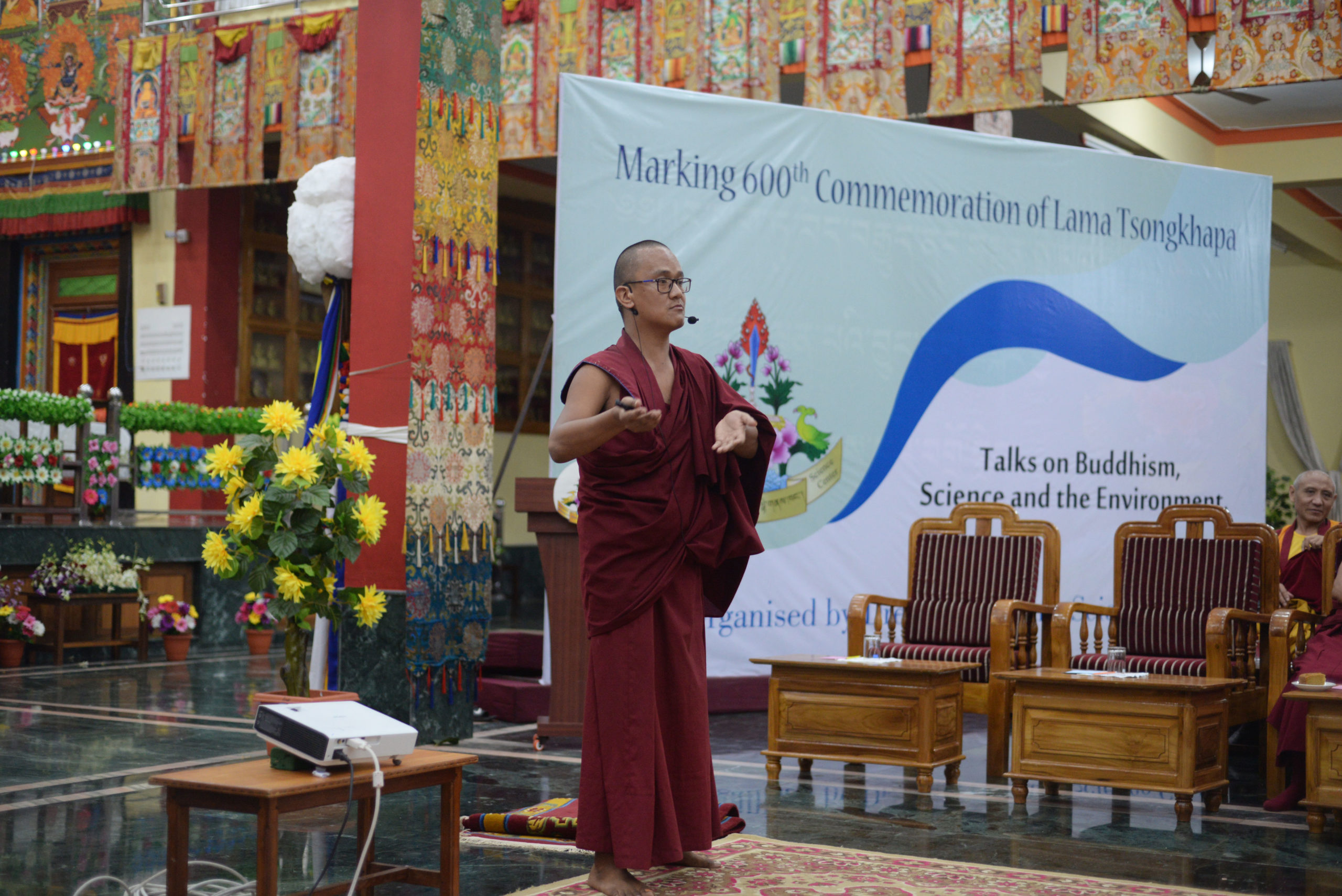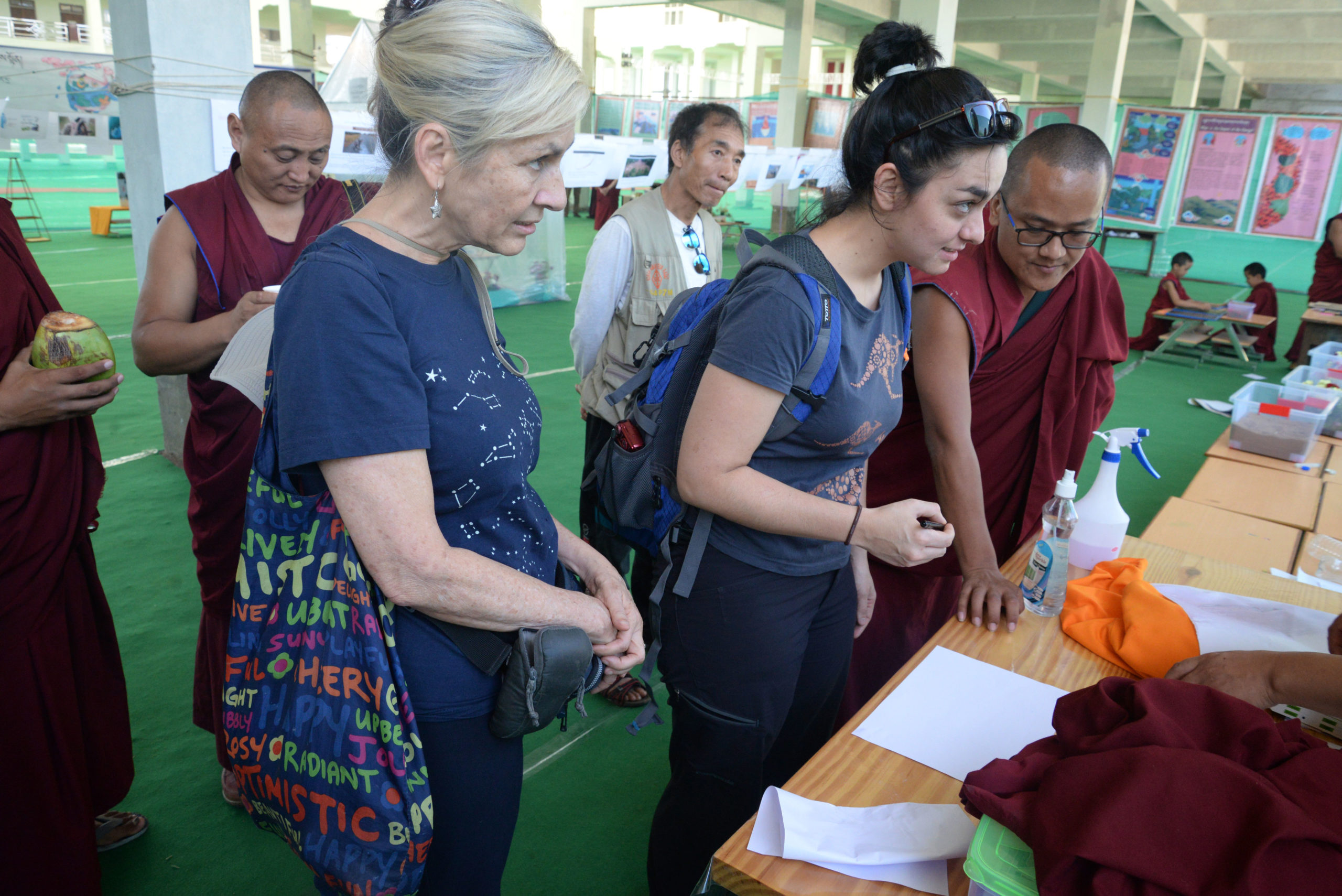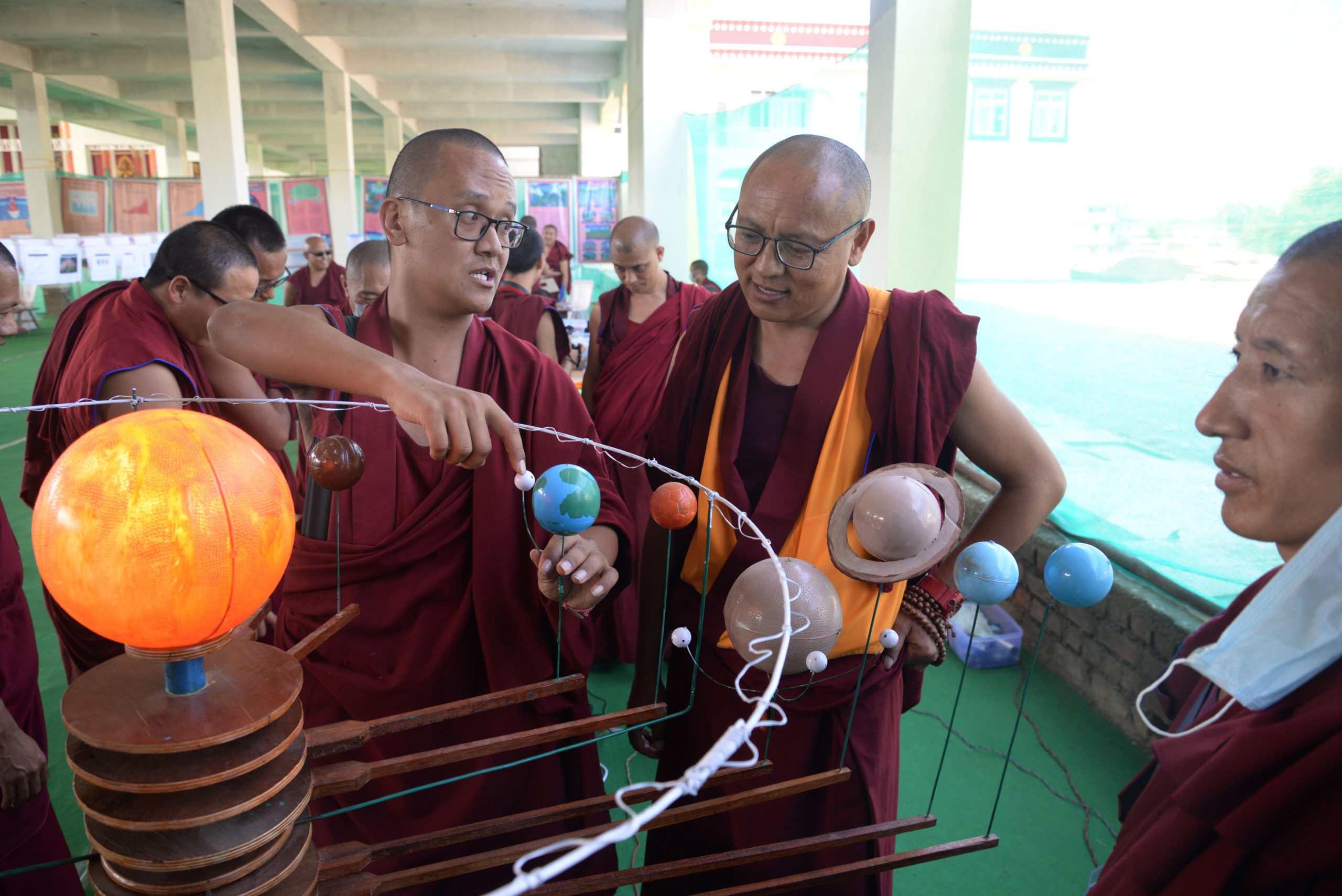Science Center Grants support individual centers and local monastic teams to implement home-grown projects. A major goal of these small awards is to support indigenous leaders and their teams. In addition to the merit of the projects, the grants pull together project teams that build a history of shared work, and develop an increased confidence to take on future challenges. Grants to individual centers often encourage creative outreach projects that extend the reach of the center to new audiences. Grants typically range from $2,000 to $10,000 USD. Projects are typically between 6 and 12 months in duration.
2019 Grants
2-Day Conference at Dzongkar Choede Main Temple
The two-day conference was the first large conference / dialogue organized by the monastery. All of the speakers were in-house, monks at the monastery. The twenty speakers were Buddhist philosophy students and scholars, 16 to 30 years old. Most were in their mid-20s. The entire monastery attended, over 250 monks, except for the youngest kids under 8 years old.
Lama Tsongkapa’s biography framed the conference. The conference presentations were developed in a novel and participatory structure. Two months of preparation and group work supported the conference, and supported new ways of learning Buddhism together. Twenty groups, of about 10 people per group, worked together to develop a paper. Each group covered a portion of Tsongkapa’s life and also covered related philosophical concepts. Nearly the entire monastery was involved in the preparation. Monks met with their groups after debate class in the evenings. Sometimes they met on days off. Each group identified one person from their group to deliver the 10 minute presentation and be the first responder for the 10 minute question and answer period that followed.
The conference was announced as: “In honor of the 600th Anniversary of Great Lama Tsongkhapa’s Parinirvana, our Zongchoe Science Center has organized a two-day conference on philosophical teachings based on the perfection of wisdom (paramita) and on various philosophical subjects. Dated September 25 and 26, 2019.”
The dialogue included conversations about science, especially during the Q&A period.
The activities and expenses include meals on two days of the conference, a publication of the twenty articles (conference proceedings), conference banners and printing philosophical text connected to the conference (a study aid for the 200 monks that worked on the conference), and a small award for best article written.
After the conference the project team reflected that teamwork and writing were a notable and important part of developing the conference. They also offered the idea that the conference was successful at strengthening education at their monastery. The monastery’s administration said that they were writing to the office of the Dalai Lama and the Department of Religion to inform them of their successful program. The project team suggested that next year (2020) they would like to organize a conference around the book by the Dalai Lama, “The Universe in a Single Atom,” so monks have a better understanding of how Buddhist and scientific points of view intersect, where they meet. The project team also shared that their project was a new way to study and learn (through group work) that is not common in the monastery. They felt this was very successful, that the monks learned new skills for analyzing, and new skills on communicating their knowledge to audiences, and they became more self-motivated.
Project Team: Gen Nyima, Gyaltsen Jampa, Lobsang (Kunga) Choephel, and over 6 monk-staff members at the monastery school.
Drepung Gomang Evening Conference and Exhibition (2-Nights)
An evening program, a conference, held over two consecutive evenings coincided with the visit of His Holiness the Dalai Lama to the Mundgod settlement. The conference was organized as a celebration of the Dalai Lama’s visit, and was the second conference organized by the science center.
The conference included short presentations, panel discussions, and responses to some of the many questions submitted in writing by the audience.
Topics were selected by the monk-presenters. Presenters were all volunteers, self-identified monks who are taking one of the six years/levels of science classes offered through the Gomang Science Center. The chosen topics included atoms, brain formation, neurotransmitters, quantum physics, evolution, and ecology.
The conference was attended mostly by monks that were also taking the same regular science classes. Between 150 and 250 monks attended each evening. The abbot of Drepung Gomang and several senior monastics attended (one of the two evenings).
Project Team: Lekpa Gyatso, Tenzin Ragba, Stanzin Wangdan, Geshe Ajig.
Gaden Shartse Development of New Science Center
In 2019, Gaden Shartse Science Center moved into a new space at the newly constructed Debate Courtyard. The monastery provided funding for the construction and some furniture for the classrooms. However, the science center team was not able to develop the main room of their center that could include office space for them to work and meet.
The main purpose of this project was to create a space for staff, monks, and friends of the new science center to meet and work and actualize plans that furthers Gaden Shartse’s engagement with science. This room is understood to be a central hub through which the monastery develops its future relationship with science.
The project expenses included two computers, one printer (Canon), one magnetic white board, a maker-space (tools and workbench), sofa and chairs for meetings, including for small group discussions, one coffee table, and 13 science-related educational wall posters of various sizes, printed and framed and hanged in the room.
Project Team: Lobsang Sopa, Ngawang Jorgyal.
Sera Mey Center Development and Science Tour to Bangalore
Funding was utilized to develop the main room of the Sera Mey Science Center to become an effective place for teachers and staff to work and meet and further the mission of their new science center. To this end, funding was utilized to purchase two desks and two new computers for the two science teachers at the science center. Prior to this purchase the two teachers did not have a desk at the science center.
The monastery provided a large empty room (with AC), but no furniture. (Similar to the situation at Gaden Shartse). This room is intended to be the main place where staff meet, visitors are received, and plans developed and acted upon.
The project team of monks organized their second science education tour for 16 monks to Bangalore. This year’s trip included a private tour of the Brain Museum at NIMHANS, a visit to the Lal Bagh Botanical Garden, and the Aerospace Museum. One of the monks was from Sera Jey and one from Dzongkar Choede Monastery.
Project Team: Lama Sangay, Geshe Topten, Jamyang Thupten, Tenzin Lobsang.
Jangchub Choeling Technology and Furniture For Science Classroom
The project team developed a plan to purchase one projector, one screen, and a handmade wooden cupboard. The cupboard was built by a local carpenter. It has a large flat table top at working level and cabinets doors for storing microscopes and other equipment. The nuns were quick to set-up the projector and screen and were very grateful to also now be able to watch remotely, live (streaming) teachings of the Dalai Lama as a group.
Project Team: Paldon Zangmo, Karma, Rigzin, Lobsang Thupten.
Eclipse Festivals at Five Locations in South India
The project supported five different teams, at four monasteries and one nunnery, comprising a total of 35 monastic science leaders and over 100 other monastics who led solar eclipse festivals that reached over 3,000 monastics and about 500 laity. These festivals took place on the morning of December 26, 2019 at: (1) Sera Lachi (main temple courtyard); (2) Gaden Lachi (main temple courtyard); (3) Drepung Lachi (main temple courtyard); (4) Jangchup Choeling Nunnery; (5) Dzongkar Choede Monastery.
The project expenses included 3,000 special eclipse glasses and viewers, snacks on the eclipse day for attendees, printing of posters and invitation cards. This project was supported and also made possible by a mentorship visit from three astronomy teachers between December 18 to 26, 2019, and the ideas they shared leading up to and during their visits.
Five groups of 20 to 30 monks/nuns were trained to lead activity stations on the morning of the eclipse. The stations provided multiple ways of safely viewing the eclipse as well as physical models that helped explain the relative positions, sizes, distances, and movements of the sun, earth, and moon. Translated postcards with eclipse basics helped viewers understand their experience. See photos in photo essay.
2018 Grants
Community Exhibition and Dialogue -- Drepung Gomang Science Center
An exhibition took place on the mornings and afternoons of November 14 and 15, 2018. The 50 stations with different models and hands-on experiences were hosted by over 100 ‘volunteer monks’ who were all first-year students of the new monastic science classes. The exhibition saw 1,600 monastic visitors and 170 Indian laity students (and 10 teachers). Most visitors stayed 1 to 2 hours, many visitors spent 20 minutes or more at a single exhibit/experience. Visitors included: (1) Science leaders from nearby monastic institutions such as Drepung Loseling, Gaden Jangtse, Gaden Shartse, and Janchup Choeling Nunnery; (2) Monastic school students from Rato, Gomang, Loseling, and Sakya; and (3) Indian students from the nearby Indian town of Mundgod.
A small conference, a dialogue, took place each evening. The conference saw talks by monastic scholars from Gomang Monastery and nearby monasteries on Buddhist philosophy, as well as talks from monastics on science, including evolution, light and color, life and cells, atoms and quantum mechanics. The conference was conducted in Tibetan. This event was the first large-scale, home-grown dialogue on science and Buddhism for Gomang Monastery. The conference followed a format where each night there were two 1-hour sessions. Each session had a 10-minute talk on a Buddhist topic, 10-minute talk on a scientific topic, and the two talks were followed by a 35-minute open discussion and Q&A session. There were 4 speakers each evening (8 in total). The conference was attended by over 250 monks each evening, mostly active monastic philosophy students.
This project was led by Ngawang Sopa, and a team of monks from Drepung Gomang, including Tsultrim Sonam, Lobsang Tsering, and Tenzin Gyatso. In preparation for the exhibition, a group of 20 monks that were going to be involved in building demonstrations for their upcoming exhibition visited nearby monastic science centers. They also visited the Agasteya Science Museum in Hubli, where they met with staff educators. These visits provided ideas for their own demonstrations, making/building strategies to employ, and encouragement–by seeing how people are learning science in different settings. Before this project, the Gomang Science Center had no tools for making demonstrations. During visits to other centers, the Gomang team made a list of essential tools and materials for their center, and these were purchased in Hubli. For three days prior to the exhibition/conference, about 100 monks worked with 4 staff from the Creative Learning Initiative (CLI), Indian Institute of Technology, Gandhinagar, to create hands-on learning experiences for the exhibition visitors. And for the two days of the exhibition, the 4 staff from CLI mentored and taught the “volunteer monk” exhibitors, with additional support from Manish Jain, the director of CLI.
2-day Dialogue, Outreach to Tawang -- Sera Jey Science Center
The Sera Jey Science Center organized its first conference and simultaneously launched a conference series, “Dialogue Between Ancient Indian and Modern Science.” The first in the series was a successful two-day dialogue (November 2-3, 2018) on “Contemporary Studies on Meditation.” About 150 monastics attended the conference that saw a range of presentations, from the Abbot of Sera Mey critiquing debate as a form of meditation to Indian university scientists’ studies on brain waves in Hindu meditators. After years of observing and participating in dialogues organized by others, this project was a catalytic opportunity for the team at the Sera Jey Science Center to envision and implement their own home-grown dialogue.
Outreach to Tawang — A team of 4 monks from Sera Jey implemented a 4-day science workshop in Tawang (3,500 km NE of Sera Monastery in Bylakuppe). Jama Lobsang, Ngawang Sherab, Tenzin Tinley, Tenzin Jangchup, and a science teacher Lhekpa (laity science teacher), worked together to implement the training. The participants were all young monks between 15 and 24 years (average age: 18). There were two parallel classes each day, with about 15 students in each (30 total). There was a senior group and a junior group. Classes were taught from 8 AM to 12 PM, saving the afternoon for Buddhist philosophical studies. A sincere attempt was made to organize the workshop in a way that did not interfere (or appear to interfere) with the ongoing monastic studies. Ngawang Sherab and Lhekpa taught physics together, on topics including light and optics. Tenzin Tinley and Tenzin Jangchup taught biology, including health and nutrition, and some introductory principles in chemistry. Jampa Lobsang was the organizer/project manager and interfaced with the host monastery in Tawang. Students alternated between the two classes/topics. The teachers reported that the students showed a lot of interest in learning science, and a lot of capacity to learn new topics.
This project was led by Geshe Ngwang Norbu, Jampa Kechuk, Kalden Gyatso, Lobsang Phuntsok, Kalden Gyatso, and additional monks from the Sera Jey Science Center.
Hands-On Making Space -- Drepung Loseling Meditation and Science Center
The purpose of this grant was to develop a new hands-on making space at the Drepung Loseling Meditation and Science Center, and to transform an empty and unfurnished room into a vibrant and safe educational space. This funding supported the purchase of building tools and supplies, simple storage shelves and organizing containers. Funding was used to purchase materials needed for building educational interactives, and conducting hands-on activities, including electrical tools such as drills, a jigsaw, circular saw, sander, glue guns, and hand-tools such as hammers, hacksaws, wood saws, clamps, pliers, screwdrivers, and basic building supplies, like nails, screws, fasteners, wood for building exhibits. This project was led by Geshe Sonam Choephel and Dr. Tenzin Pasang. This project also directly engaged 20 monks and science leaders for seven days. They were closely trained by faculty on each day of a coinciding mentorship visit. Additionally, 20 Tibetan school students (and 5 local school teachers) visited the new making space on two separate afternoons.
Center Development -- Dzongkar Choede Science Center
The purpose of this grant was to develop the capacity of the science center at Dzongkar Choede Monastery, where 300 monks live, learn, and practice Tibetan Buddhism. The project team identified several small changes, such as additional new furnishings and educational resources, they thought would improve the science center, and advance their capacity to host large gatherings/workshops of monastics and Western faculty. Purchased materials included printing of new graphics for panel exhibitions on the walls of their center and two whiteboards, each 8 feet in length. Less than 10% was spent on consumables such as paper, drawing pens, and tape. The project team went shopping together in Mysore and worked together to install the new whiteboards and exhibit graphics. This project was led by monastics Gen Nyima (Thupten Nawang), Thupten Choklang, Lobsang Choephel, and Lobsang Gonpo.
Science Resource for Newly Constructed Library -- Tashi Lhunpo Monastery
This project was led by Kachen Lobzang Tamchos, who is co-leading a project to build a new library at his monastery. Kachen Lobzang suggested building a science section in the library and purchasing some science books as a strategy to help establish a dedicated space in the new library. No funding was used for the construction of the library. The purpose of the grant activities was to support the purchase of books and help create a ‘science section’ in the newly constructed (completed in 2018) monastic library.
Classroom Furniture, Tools for Making Space -- Gaden Jangtse Science Center
The purpose of this grant was to support the purchase of new multi-purpose tables for classrooms, group work, and meetings. These tables are excellent for group work and make it much easier for teachers to incorporate activity-based and group learning into their lessons. With an increase in the number of students taking science classes at Gaden Jangtse, science leader Lodoe Sangpo requested support to purchase 45 new classroom tables. The rectangular tables are made from wood and can easily be rearranged to support small and large group work, laboratory experiments, or can be lined-up in rows for taking notes during a lecture or film screening. The tables were 60% of the total project cost. The remaining 40% was spent on wood, simple tools, and other building materials, such as hardware, paint, tape, glue, all of which were used in the science center’s making-space launched in 2017. This project was led by Lodoe Sangpo, Yeshi Dorjee, with additional support from monks from Gaden Jangtse Science Center and staff from the Jangtse Education and Cultural Society.
Microscopes and Classroom Furniture -- Jangchup Choeling Nunnery
This project helped develop the new science classroom at the Jangchup Choeling Nunnery by purchasing two microscopes and new tables, making the classroom better suited for group work and hands-on learning. This project was led by the nunnery’s administration. They requested support to purchase classroom microscopes and tables. The nunnery has shown a strong commitment to continue science training for the nuns.
Development of Sager Science Center, Library of Tibetan Works and Archives
This project supported the development of the physical spaces at the science center including: (1) Translation and printing of educational wall-charts with bi-lingual graphics; (2) Development/mentorship visit from Scott Schmidt (Smithsonian) – Scott took steps with staff at the science center to develop educational resources and new outreach capacity. Significant purchases included new power tools, e.g. a router, drill press, and additional hardware and building materials for hands-on learning. The project also purchased and installed a ceiling projector and automated roll-down screen in the classroom; (3) Growing the collection of books at the science library (within the “Lab” on the ground floor). The Science Department has already collected about 500 science reference books, including classic works, science teaching references, and Tibetan language science publications, and this project added over 50 new titles; and (4) Construction/Building Improvements – including (a) remodeling all 12 front-facing windows to include Tibetan architectural features (traditional black frame and top-runner with Tibetan-style design; (b) installing a tile flooring on the top (4th) floor. This project was led by Geshe Lhakdor, Karma Thupten, Paldon Tenzin, Karma Tsundu, Tsewang Rinzin, Tenzin Kunkyap. This project was funded by the Sager Family Foundation.
2017 Grants
Science Center Launch and Community Exhibition -- Dzongkar Choede Science Center
This funding supported the creation of a ‘maker space’ to develop and launch the recently constructed science center at Dzongkar Choede Monastery. A two-day exhibition, “My Earth, My Responsibility,” was a community event and informal celebration of the new space for science at the monastery. Nearly 1,500 people attended the exhibition, including 600 local Tibetan (laity) students, and 300 Indian students and 20 of their teachers. The two-day exhibition (August 15th and 16th) drew audiences young and old from the local community, ranging from monks to lay people to local students.
A nine-day development workshop took place leading up to the exhibition. A nine-member team consisting of local monastics and visiting mentors led the development of the center. Ravi and Manish, from the Indian Institute of Technology Gandhinagar, led scientific exploration with simple materials, helped prototype new interactives and develop the space of the science center. Yeshi Dorje from Gaden Jangtse and Gyem Tsering from Bhutan worked with local monks to build exhibits. Bryce Johnson (Science for Monks and Nuns) oversaw the activities, worked with Ravi and Manish, and also built many small activities based on exhibits he learned at the Exploratorium. Two trips to Mysore and several trips to the nearby town of Hunsur were made to purchase building tools and supplies. To organize the materials, two large shelving units and containers for storing and organizing supplies were purchased. This grant purchased electrical tools such as a drill, jigsaw, circular saw, sander, and glue-gun, and hand-tools such as a hammer, hacksaw, wood saw, clamps, pliers, screwdrivers, and a few basic building supplies, like nails, screws, fasteners, wood for building exhibits, as well as basic teaching supplies, such as scissors, scales/rulers, glues, tape, magnets, marker pens, and paper. Local monastics (from Dzongkar Choede) Gen Nyima (Thupten Nawang), Thupten Choklang, Lobsang Choephel, and Lobsang Gonpo from Dzongkar Choede organized and oversaw this project.
Community Exhibition “World of Your Senses” in Tawang -- Sera Jey Science Center
A three-day exhibition was organized in Tawang, India, to reach local laity students in this very remote part of the Himalayas. Over 1,400 middle school and high school students from 16 different local (laity) schools attended the exhibition, typically staying at the exhibition for 1.5 to 3 hours. About 200 local monastics from Tawang also came to the event. The opening of the exhibition saw participation by prominent community leaders. The exhibition was preceded by a six-day preparation workshop (October 12-18), 3 to 4 hours each day, led by the science leader team to train the local exhibitors. Three of those six days were a workshop on the content of the exhibition, followed by three days for local exhibitors to practice presenting the exhibition panels and the hands-on activities. The local monk exhibitors were mostly from class 8 and 9. They had studied some science in the (Indian Government) school at their monastery, but the topic of the exhibition (sensory perception) was new to them. The nuns involved had no background in modern education. On the first day of the workshop, only 3 nuns came, but on the following days they brought more and more nuns, and eventually a total of 10 nuns were part of the local exhibitor team.
Science Leader Team: Jampa Lobsang (Team Leader, Sera Jey Monastery), Tenzin Khewang (Nechung Monastery), Dhondup Gyaltsen (Menri Monastery), Gen Nyima (Dzongkar Choede Monastery), Nyima Sangey (Tawang), Ani Tenzin (Janchup Choeling Nunnery). The science leader team trained a wider team (local exhibitors) of 36 monks and nuns: 22 monks from Sera Jey Jamyang Choekling (a branch institute of Sera Jey Monastery); 4 monks from Tawang Gaden Namgye Lhatse Monastery; 10 nuns from Gyagong Nunnnery. In the early development of this project, the project leaders remarked: “Only a few people come to listen to a lama sitting on a throne and giving a talk, but an exhibition, like the one planned, is an opportunity to engage audience members that might not otherwise participate. It’s a more fun and engaging way to facilitate this needed dialogue.”
Schools Invited to Exhibition (Most Attended): 1) Mukto Middle School (Public); 2) Mukto Secondary School (Public); 3) Gomkeling Middle School (Public); 4) Kitpe Secondary School (Public); 5) VKV Secondary School (Private); 6) Audung Middle School (Public); 7) Tawang Public (Secondary) School, Lembardung (Private); 8) Bomba Middle School (Public); 9) Tsangprong Middle School (Public); 10) Jang Secondary School (Public); 11) Kakaling Middle School (Public); 12) Higher Secondary School, Tawang (Public); 13) Tawang College (Public); 14) Tawang Secondary School (Public); 15) Mount Geshela School (Private); and 16) Arunachal Public School (Private).
About Tawang – Although within the borders of India, Tawang is traditionally a Tibetan Buddhist area in the Himalayan region, on the Tibetan plateau. The people of Tawang have followed Tibetan Buddhism for centuries. The oldest monastery in Tawang is more than 300 years old, and there are several sacred Buddhist sites, like caves that are 1000 years old (7th century). Tawang was the birthplace of the celebrated 6th Dalai Lama. The 14th Dalai Lama has mentioned at recent public audiences that the monks from the Himalaya regions, like Tawang, are important for the future preservation of Tibetan Buddhism.
Center Development and Launch -- Sera Mey Science Center
This project had two parts: (1) An overnight trip to Bangalore (6 hr drive away) to visit two Indian science centers: The National Science Museum, and Jawaharlal Nehru Planetarium. The purpose of the visit was to see how these spaces and learning experiences are constructed, and to look for strong ideas to bring back to their science center; (2) Developing new exhibits for the new Sera Mey Science Center, procuring furniture for different classrooms and lab space, and a small exhibition made by the science students at Sera Mey to correspond with the center’s inauguration by His Holiness the Dalai Lama. The Sera Mey Educational Society covered about 50% of the costs for the classroom and lab furniture. This mini-grant covered the remaining costs.
Project Leadership Team (mostly 2nd and 3rd cohort science leaders) included: (1) Jamyang Thupten, (2) Lama Sangey, (3) Geshe Wangchuk, and (4) Tenzin Lobsang. Additional project team members: (5) Tenzin Geche, (6) Lobsang Damchoe, (7) Ngawang Samten. Twenty monks, the project leaders, plus 13 additional monks active in the science program at Sera Mey travelled to Bangalore to visit the two Indian science centers. The monks captured photos and videos of the exhibits they liked, and when they got home they made 8 different exhibits based on and inspired by what they found in Bangalore. The project leaders commented, “Some of the things we could make ourselves and some of the things look complicated.” And: “The things we could touch and try ourselves were easy to understand.” To correspond with the inauguration of the center, the science leaders organized an exhibition that was prepared by students in the science classes.
Center Development and Launch -- Tibetan Library, Dharamsala
This project supported purchase of new equipment and space modifications that allowed for the activation of the new center by developing the: (1) maker space/room; (2) small exhibition hall/laboratory; (3) classroom; and (4) two office spaces for the five staff members of LTWA’s science department. This funding was allocated for materials and equipment, such as classroom and office furniture (desks, chairs, tables, shelving), computers and office printers for science staff, and educational wall charts/posters (printing and framing costs). This project was funded by the Sager Family Foundation.
Center Programs and Site Development -- Gaden Shartse Science Center
This project supported the launch of a new science center at Gaden Shartse by providing material resources and by supporting the launch of new programs implemented through the Gaden Shartse Science Center. The team at Shartse identified seven activities to develop the center: (1) Book shelves, tables, chairs, and whiteboard for the library of the science department and classrooms; (2) Reference textbooks; (3) Student presentation events on writing, chapters learned and a variety of special topics, a presentation in the presence of the students, teachers and experts invited; (4) Two- or three-day panel discussions with experts and students invited from different monasteries and schools; (5) Publication of an annual science magazine by the department to further the understanding of science, and to provide a platform to research on different topics in science, for the students to arouse interest in science among each other; (6) For the monthly usage of internet to download teaching materials and for students to learn through the internet; and (7) Whiteboards.

